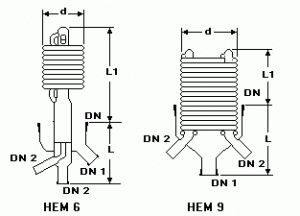|
Boiler
Catalog
Reference
|
Surface
Area
ft2
|
Steam
Pressure
psig
|
Water Evaporated
lbs/hr
|
|
GHEB4
|
1.5
|
15
|
4.2
|
|
50
|
10
|
|
GHEB6
|
5
|
15
|
14.3
|
|
50
|
33
|
|
GHEB9
|
15
|
15
|
42
|
|
50
|
99
|
|
GHEB4/4
|
1.5
|
15
|
4.2
|
|
50
|
10
|
|
GHEB6/6
|
5
|
15
|
14.3
|
|
50
|
33
|
|
GHEB9/9
|
13
|
15
|
31
|
|
50
|
99
|
|
GHEB12/12
|
20
|
50
|
123
|
|
GHEB450
|
45
|
50
|
198
|
Heat Transfer in Boilers
The overall heat transfer coefficient for any 4", 6", 9" or 12" unit is generally about 70 Btu/hr-ft2-°F. This is based on 50 psig steam pressure in the coils, although it declines proportionately at lower pressures. The heat transferred for the 18" unit is approximately 54 Btu/hr-ft2-°F.
The table shows representative performance data of boilers, indicating the amount of water evaporated at atmospheric pressure, with steam in the coils at various pressures.
If the feed is cold, the evaporation rate will be approximately 85% of the figures shown
 .
.
Notes on the use of coil type boilers
-
To avoid the possibility of steam hammer, the steam main should be adequately trapped.
-
To clear the line of the very heavy condensate flow produced on startup, bypass valves must be fitted around the trap on the coil outlet.
-
The control valve and pressure gauge should be near the heat exchanger.
-
Flexible hose must be used on the coil inlet and outlet, and these hoses should have sufficient fall to avoid collection of condensate.
-
Boiler type heat exchangers should not be fitted to the bottom of flasks or columns. They are designed to be mounted on an external circulatory loop. This assures a rapid unidirectional flow across the heating surface, which improves the heat transfer performance and promotes smooth operation.
-
On startup, the steam should be admitted positively and progressively to the coil/battery to remove the condensate as it is formed. The bypass valve should be left open until a uniform flow of condensate and steam is being vented.
-
The steam pressure should always be adequate to assure effective and smooth condensate removal. This pressure will vary according to conditions of use and size of heat exchanger. For example, with the HEB12/12 and HEB450 a minimum pressure of 30 psig will probably be required.
-
The maximum recommended inlet steam pressure for all boilers is 50 psig.


 .
.